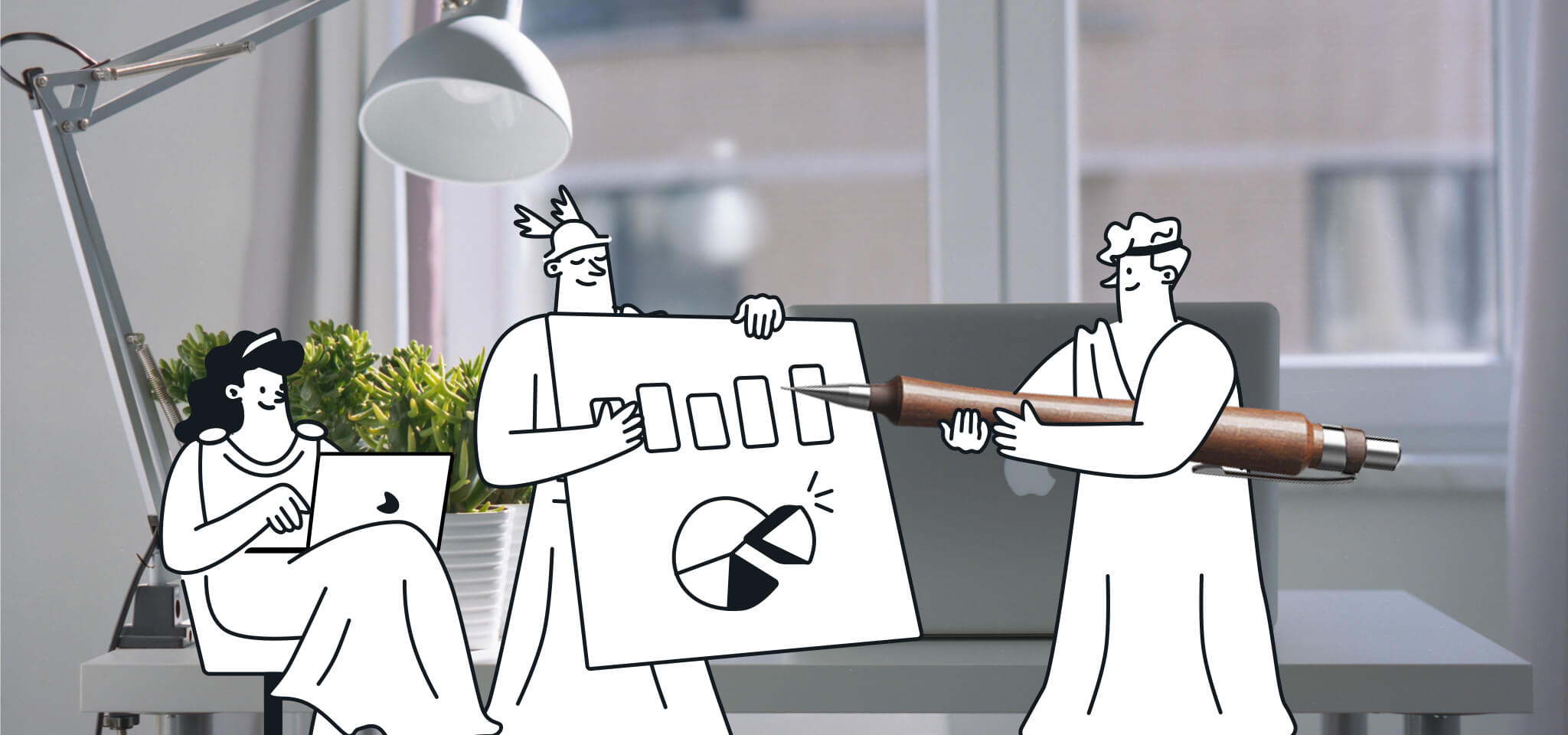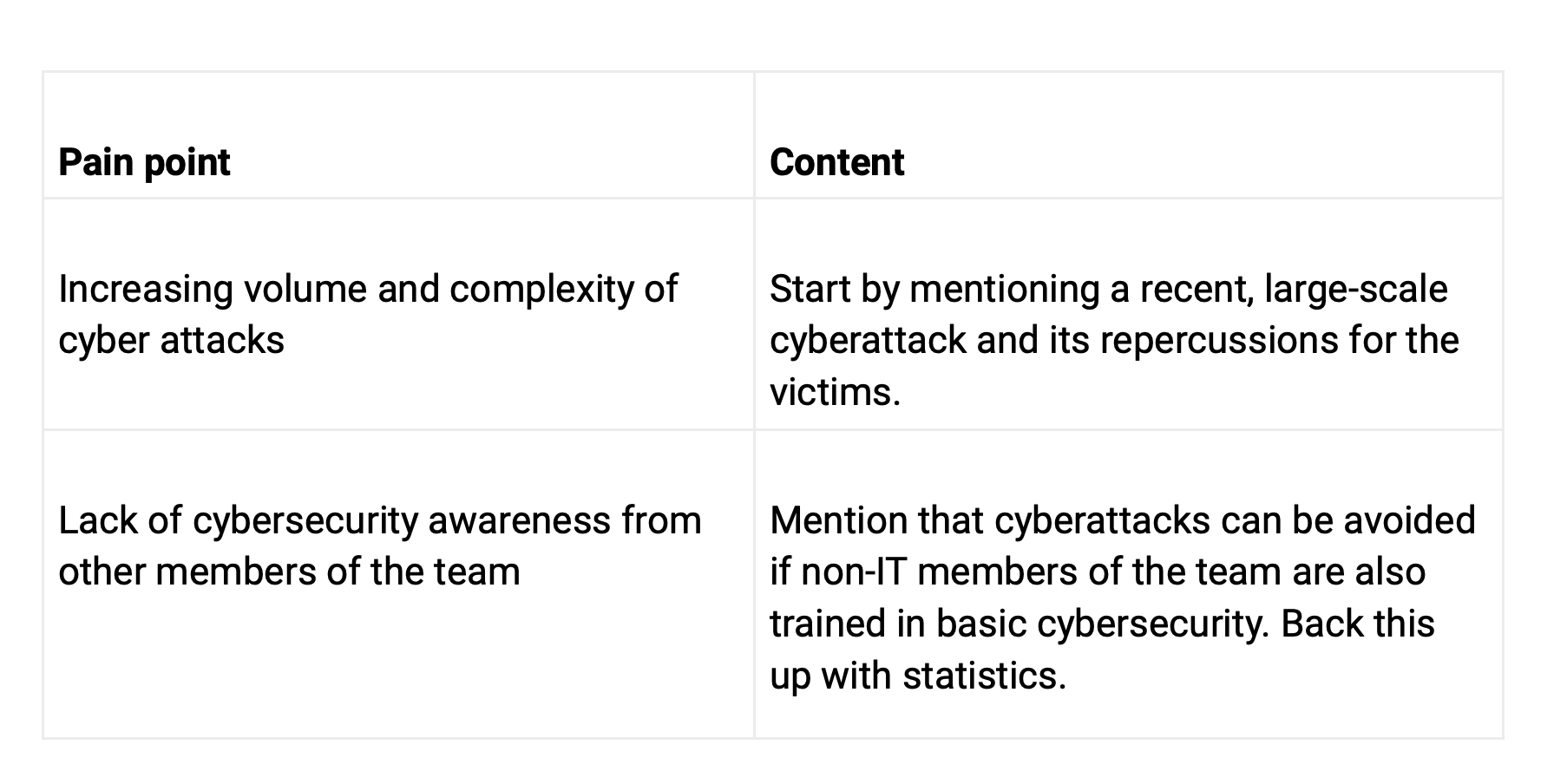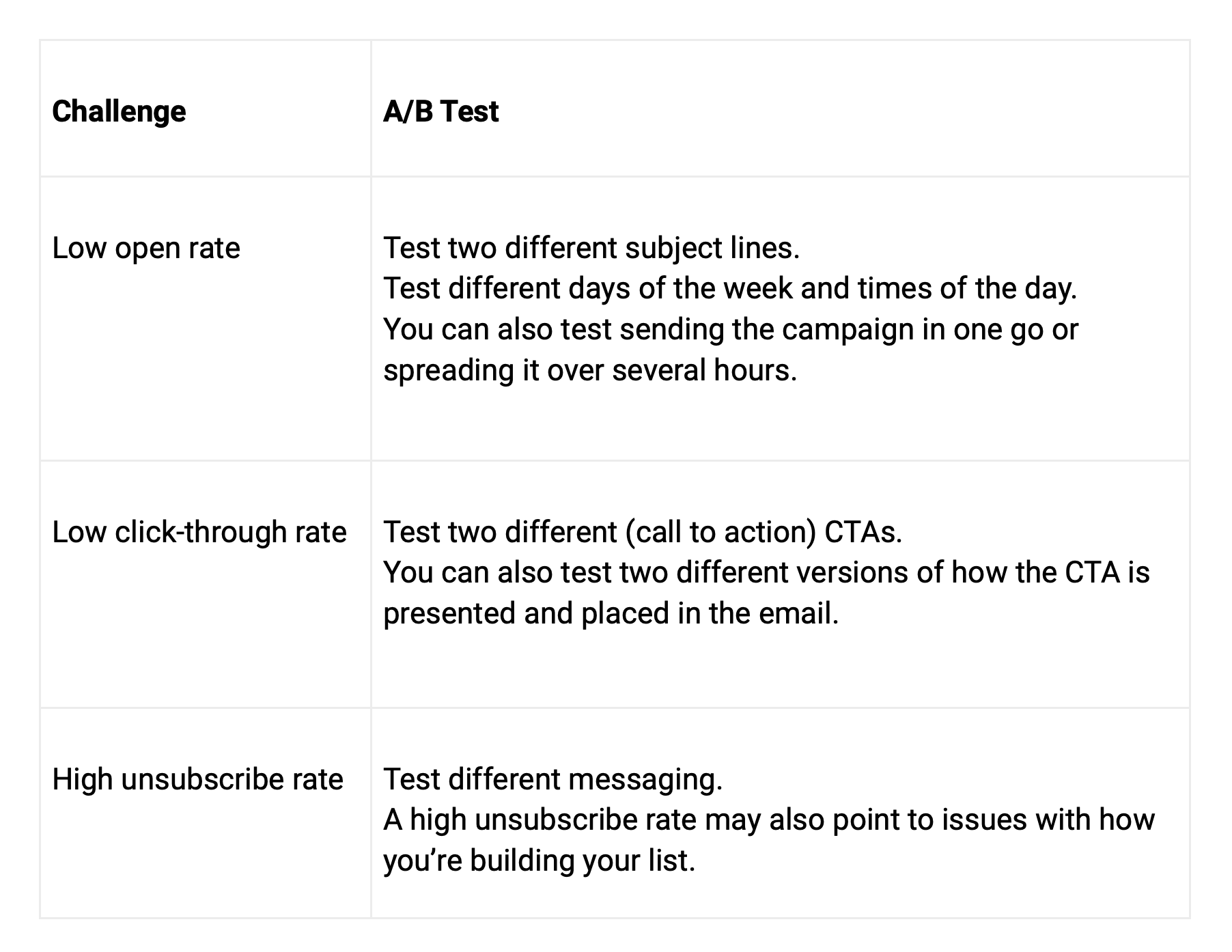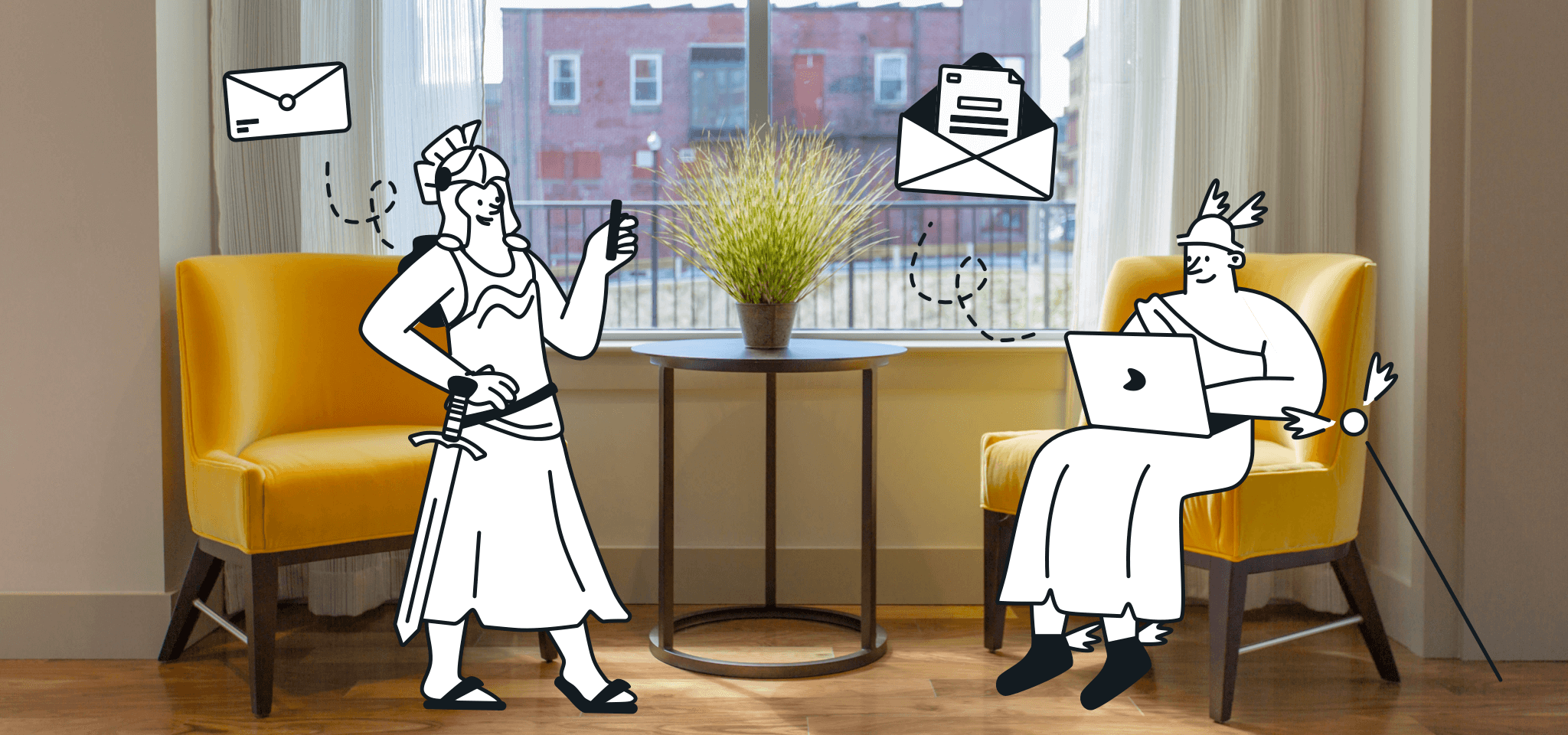Email best practices
Ultimate guide to B2B email marketing
Want to turn email into your most powerful marketing channel? Read this ultimate guide to b2b email marketing.

PUBLISHED ON
If marketing was a competition, email would win hands down. The ROI of email marketing is £42 ($57) per £1($1.36). That’s a 4,200% return on investment (ROI). To put things in perspective, search engine optimization (SEO) has an ROI of 317% and pay-per-click advertising (PPC) 200%. Is it surprising then that in the business-to-business (B2B) world, 59% of marketers prefer email marketing for lead generation?
Like a B2B swiss army knife, you can use email marketing to educate users about your brand, nurture your existing leads, generate new leads, turn prospects into customers, and keep your current customers engaged.
The secret to creating a successful B2B email marketing strategy is meticulous planning. You need to define your objectives, determine your KPIs to measure performance, create your message map and roadmap, execute your plans, and monitor your results. Before we get into the nitty gritty , let’s cover some basics.
Table of content
Is email marketing effective in a B2B environment?
Why is B2B email marketing so effective?
B2C vs. B2B email marketing
Build and grow your email list
Segment and clean your email list
Create a message map for each segment
Plan different A/B tests for each segment
Plan user-behavior-triggered email campaigns
Plan drip campaigns
Plan one-off/manual email campaigns
Create an email marketing roadmap every month
Analyze results and tweak your strategy accordingly
Send emails on Tuesdays and Thursdays
Include sender name, address, and an unsubscribe link in all your emails
Use plain text emails when possible
Create original and personalized subject lines and email content
What is B2B email marketing?
In short, B2B email marketing is a type of marketing in which you send email campaigns to businesses instead of individual buyers. You engage sales prospects (B2B buyers) through their work email, educate them about your products, and convert them into marketing qualified leads (MQLs) for the sales team.
Is email marketing effective in a B2B environment?
Email and B2B are a match made in heaven. 49% of the 150 U.S. B2B marketers surveyed by eMarketer rated email as the best channel for driving engagement, and 48% rated it as the best channel for driving conversions. That, along with the unbeatable 4,200% ROI, makes email one of the most important marketing channels for B2B companies.
Why is B2B email marketing so effective?
Everyone who works for an organization has a work email address. Companies assign new employees their work email as part of the onboarding process.
43% of professionals check their work email outside of work hours, so you have a chance of reaching them if you can find a way into their inbox.
So if you know your buyer persona and successfully build a list of email subscribers that fit that persona, you can start sending out B2B email marketing campaigns to a highly targeted audience. On average, you can get a 23% open rate and a 5% click-through rate (CTR) with a manual (one-off) campaign. To put things in perspective, the average CTR on Google ads is 1.91%. You can get traffic and leads, and consequently revenue, through email marketing. That’s why companies spent £62,000 ($84,355) on email marketing in 2019. This tops the average annual spend of £57,000 ($77,552) in 2018 and £49,000 ($66,668) in 2017.
B2C vs. B2B email marketing
Email marketing is the golden goose. Whether it’s B2B or B2C, aims for better customer engagement and higher revenue generation. Generally, B2C email marketers push a product and get the email recipient to make a purchase then and there. Success is calculated in terms of revenue.
In contrast, B2B email marketers try to educate the user, move them along the sales funnel, and help the sales team. Success is measured in terms of MQLs generated.
B2B and B2C email marketers measure success differently because the email recipients in both cases have different decision-making authorities. The recipient of B2B emails is a decision-maker or stakeholder who represents an organization. They have a much bigger budget compared to a B2C email recipient, and they must consider a lot of data points before they can go ahead with the purchase. Also, in most cases, multiple people are involved in the process before making a final decision.
In short, the content in both B2C and B2B emails caters to the motivation of the user. As a B2B marketer, you need to put yourself in the shoes of B2B buyers, understand their challenges, and reach out to them with content that is of interest to them.
How to create a successful B2B email marketing strategy
Your marketing strategy is your game plan to reach your prospects and turn them into customers. With an email marketing strategy in place, you go after your objectives in an organized manner. Here’s a step-by-step process you can follow to build a B2B email marketing strategy for your organization.
Define your objectives and determine clear KPIs to measure success
Your objectives are the why behind your email marketing channel. They’re the purpose behind your marketing strategy and, in turn, shape how you execute it. Common email marketing objectives include increasing customer engagement, retaining existing customers, and moving customers from one stage of the conversion funnel to the next.
Your KPIs are how you quantify and measure your objectives. So, your objectives will help you determine which KPIs to track. Primary KPIs typically include the number of marketing qualified leads (MQL) to sales qualified leads (SQL) ratio, pipeline generated by email marketing, and pipeline-to-revenue conversion. Common secondary KPIs include traffic generated through email, open rate, click-through rate, and percentage of active users.
Here’s a table that shows common B2B email marketing objectives and their corresponding KPIs:

Build and grow your email list
Before you do any kind of email marketing activity, you’ll first need to build a decent-sized email list. If you’re just starting to build a list of opt-in users, 1,000 is a good size for your first campaign. Your email list is the total number of contacts you collect as a result of people subscribing to receive emails from you.
Think of an email campaign going out to 100 people. Let’s assume 23% of those people open that email (open rate), and 5% of them click the link in that email (click-through rate). Those who clicked the link made it to a page on your website (a landing page), and that landing page has an opt-in form that only 5% of them are likely to fill out (the conversion rate of the landing page).
Since the size of your email list is 100 subscribers, you will get 23 people to open the email, one to click through to your landing page, and zero to fill out the form (subscribers/leads). To get even one lead from this campaign, either your page has to have an impossibly high conversion rate of 100%, or you need an email list of at least 2,000 people.
So how do you go from 100 to 2,000 email subscribers?
Growing your email list the right way is difficult but not impossible. You can get people’s consent for sending them emails by having them subscribe to your email newsletter or sign up for gated content such as ebooks, guides, webinars, demos, video tutorials, whitepapers, free trials, and free consultations. You’ll need to work closely with other marketing channels, such as social media marketing and content marketing, to promote gated content and get your prospects’ email addresses in return for something of value to them.
Segment and clean your email list
Email segments are like different flavoured ice cream in a parlour. The flavors are subsets of your email list created on the basis of a single or multiple common traits between contacts. Segments enable you to send highly personalized and targeted campaigns. Having a segment based on job title and industry will help you create email campaigns that target specific people in specific positions in specific industries. As a B2B email marketer, that’s exactly what you want.
Another way to create segments is to have a separate segment for each of your buyer personas. You can also create segments based on multiple traits such as recent activity, type of activity, job title, region, company, and industry.
Besides creating segments, you must also clean your email list frequently. Cleaning up means removing inactive users from your list. You do this to ensure higher deliverability and better sender reputation. If you have an outdated email list where a lot of email addresses are no longer valid, your emails will either start bouncing back or sit there unopened in an inbox no one uses anymore. In either case, your sender reputation will be affected.
Your sender reputation or sender score is how internet service providers determine whether you will end up in someone’s inbox or spam folder. Therefore, you have to clean your list and always aim for a higher open rate and 0% bounce rate.
Create a message map for each segment
Think of a message map as a cheat sheet for every time you want to create content for a new email campaign. Your message map contains your buyer persona, the problems they face, how you solve these problems, and the keywords that appeal to them. This is what a message map for one persona looks like:

When creating an email campaign for a product relevant to this persona, you can open your message map and immediately get a lot of content material for your email. In this example, the product is a cybersecurity certification course. Here’s how the pain points can help you get content for the campaign:

This will give you the beginning and middle of your email. After that, you transition into the ‘messaging’ part, where you encourage the reader to get certified or get training for their non-IT team members, and then you place a call to action at the end.
A message map comes in handy when you’re planning multiple campaigns for multiple personas. With the help of a message map, you can make sure your content is in line with the user’s motivations and pain points.
Plan different A/B tests for each segment
An A/B test is where marketers become scientists. A/B testing is when you create two or more different versions of one variable from your email and split it between members of the same segment of recipients. That variable can be the subject line, an image, a call to action, or the layout of the email.
By using A/B tests and then studying the results, you can pinpoint what does and doesn't work with your email campaigns, and you can improve them one targeted element at a time.
Here are some challenges you may come across in your email campaigns and their corresponding A/B tests:

Plan user-behavior-triggered email campaigns
How often have you checked your inbox after making a purchase, just to make sure the order has gone through? It’s for this reason that setting up personalized user-behavior-triggered campaigns, like transactional emails or automated campaigns, is essential. They are timely and relevant, and they can earn you 24X more revenue than your regular campaigns.
Users perform a number of actions when they interact with your website or your emails. You can set up automated email campaigns based on each user action. These actions can be:
Opening a particular email
Clicking on a particular link
Visiting a particular page on your website
Visiting your site or a page on your site multiple times
Purchasing a product
User-behavior-triggered email campaigns kick into action as soon as the user completes certain actions or meets a certain condition. For example, a company that sells fleet monitoring systems can set up user-triggered campaigns for users who visited their “fleet tracking system for small businesses” page three times in 30 days. That campaign can have a series of emails, starting with educational emails about fleet tracking then slowly transitioning to talking about the benefits of the company’s solutions by the third or fourth email.
To set up these email campaigns, first identify all the use cases for which those campaigns should go out. Every action the user performs represents (which merits an automated email) is a use case. You can work with multiple stakeholders, especially the product marketing manager, to define and identify these use cases.
Plan drip campaigns
Drip campaigns are a series of emails that take the user through a journey from one stage of the conversion funnel to the next. They are often set up as automated emails and the entire series features a number of time-based campaigns (i.e., one email follows the next over a set number of days). These campaigns are important because they help you send the right message to the right user at the right time.
If the user interacted with a top-of-the-funnel asset such as a blog post, it's your job to get them to interact with middle-of-the-funnel assets such as case studies and then bottom-of-the-funnel assets such as a product page. You can achieve this through a drip campaign.
Usually, these campaigns follow this pattern:
Stage 1 – Educational and interesting content, leading to a relevant blog post on your website.
Stage 2 – Data-heavy content that compares two products or discusses the pros and cons of a product or a service, leading to a relevant resource on your website.
Stage 3 – Email that encourages the user to sign up for a free trial, demo, or consultation, leading to a product page or landing page built for collecting leads.
The number of emails in each stage is up to you. It’s a good idea to study historical data and current user trends before you design these campaigns.
Plan one-off/manual email campaigns
One-off email campaigns are special campaigns you do once a month or even every two weeks. These campaigns are different each month and can range from end-of-the-season sales to a webinar announcement or newsletter. One-off/manual email campaigns are important because you will need to share updates, promote new products, conduct surveys, etc. You can automate some of these campaigns for future use.
When planning these campaigns, make sure they don’t overlap with your automated campaigns. That’s why it is a good idea to create an email marketing roadmap.
Create an email marketing roadmap every month
Deadlines can be marketers' worst nightmare, but they can actually eliminate stress if followed diligently. This spreadsheet makes sure all email campaigns (except automated emails) are listed, along with time, date, subject line, and segment. This is what a B2B email marketing roadmap looks like:

Making this roadmap every month helps you stay organized. By doing this, you make sure you’re not missing any segments or going overboard with other segments.
Analyze results and tweak your strategy accordingly
After you have a message map and a roadmap, it’s finally go-time. The results of your campaigns are the same as the KPIs you determined earlier. Keep an eye on the metrics (delivery rate, open rate, click-through rate, and MQLs) you decided were important when you created your strategy.
Analyzing results and tweaking your strategy is important because you may not be achieving some of your goals with the first iteration of your email marketing strategy. If that’s the case, you’ll want to find out what’s lacking in your strategy.
For example, if you didn’t generate enough MQLs through the free demo campaign sent out on the 14th, you’ll look into the delivery rate, open rate, click-through rate, and landing page conversion, then try to find the culprit.
You can do this by the process of elimination:
Was the conversion rate on the landing page up to the industry standards?
Did you send enough traffic to the page to hit its MQL target?
Did people read your email (open rate)?
Did enough people click the link (click-through rate)?
By answering these questions, you’ll narrow it down to one issue and take steps to address it. If you found that everything was as per industry standards or better, but the size of the email list was too small to hit the target number of MQLs, you know where to focus your efforts.
Similarly, if the click-through rate was below average, you can plan an A/B test on the call-to-action in your next campaign.
B2B email marketing best practices
Failing to prepare is preparing to fail. So having a strategy, a roadmap, and a message map will help you go after your objectives in an organized way. Furthermore, you should follow these best practices to improve your sender reputation and get the most out of your efforts:
Send emails on Tuesdays and Thursdays
Tuesdays and Thursdays are the best days to send email campaigns.
Start with these days as the baseline and also experiment to find your best day.
The best time to send B2B emails is in the morning.
We have more data on the best time to send email newsletters, including countries, time zones, and frequency.
Include sender name, address, and an unsubscribe link in all your emails
You need to have this in your email. Without it, a good email provider will not allow you to send an email. Even if you manage to do so, it’s against the CAN-SPAM Act and will hurt your sender reputation.
Use plain text emails when possible
We can all agree HTML emails are eye-catching and beautiful. However, they have a lower delivery rate compared to plain text emails.
Plain text emails have a much better chance of landing in the recipient’s inbox. Also, if the messaging is highly personalized, it will look and feel like an email from one person to another as opposed to an email from a company to an individual. As a best practice, you should always have a backup plain text email for every HTML email you send. You can set it up in a way that it will automatically send if the HTML email doesn’t make it to the user’s inbox.
Create original and personalized subject lines and email content
You have to empathize with the recipient’s motivations and problems to write subject lines that will cause them to open the email. Look at these subject lines:

The first one from Wealth-Management is straightforward and gets to the point without any element of creativity. Anyone who transfers funds from one currency to another will be interested in opening this email.
The second one from Morning Brew is “Everyone’s Quitting.” This is creative and will pique the interest of anyone who regularly receives emails from them. However, this can backfire with first-time recipients because they may think of it as clickbait.
As a rule, when you A/B test different subject lines, make sure one of the subject lines contains words from your message map.
You can even use variables that place the recipient’s name, geographic location, job title, or industry in the subject line. In addition to these variables, you can place information that’ll personally speak to the email recipient.
For example, say you represent a company that sells cybersecurity software to multiple industries. You have a segment of cybersecurity professionals from the banking industry. What would be a good subject line for a campaign introducing them to your software?
This feature of XYZ software helps protect banks from ransomware attacks.
Your banking system is vulnerable to cyberattacks; Here’s what you can do.
XYZ bank successfully blocked X cyber attacks last quarter.
Getting back to the topic of personalized content, remember that personalization is not just about putting a name in the subject line. The content of the email should be specific to the needs of the recipient. It should be worth the two minutes they’ll spend reading the email. With that in mind, a B2B email shouldn’t be longer than 150 words.
Additionally, before sending out an email campaign, make sure that:
There’s no $ sign, the word ‘free,’ or similarly salesy words in the subject line.
You only use links that are absolutely necessary for the email. Ideally, there should be only one link.
Your CTA is clear in words and visual representation.
Execute your B2B email marketing strategy with Mailjet
Congratulations, you now know how to create a successful B2B email marketing strategy. However, to get this show on the road, you’ll need a powerful email services provider that helps you land in your prospects’ inboxes.
Mailjet helps you get a better sender reputation, improved delivery rates through a reliable infrastructure, and smarter solutions based on machine learning. You can send marketing campaigns and transactional emails and automated email campaigns. And you can track results with the help of powerful email analytics. To learn more about how Mailjet can help you make the most of your B2B email marketing strategy, talk to a strategist today.








